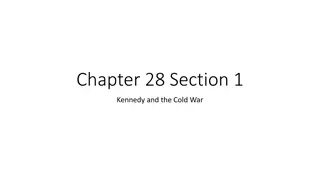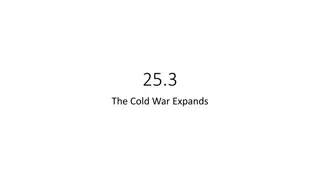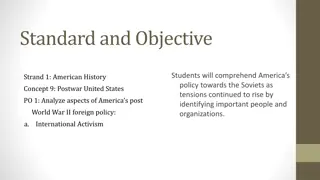Overview of the Cold War: Tensions, Divisions, and Key Events
The Cold War was characterized by the rocky relationship between the U.S. and the Soviet Union, the division of Germany and Poland, the concept of the Iron Curtain, the Truman Doctrine, military alliances like NATO and the Warsaw Pact, and the political dynamics of the Korean War. Tensions over differing ideologies, nuclear weapons, and control of Eastern Europe marked this era of global conflict.
Download Presentation

Please find below an Image/Link to download the presentation.
The content on the website is provided AS IS for your information and personal use only. It may not be sold, licensed, or shared on other websites without obtaining consent from the author. Download presentation by click this link. If you encounter any issues during the download, it is possible that the publisher has removed the file from their server.
E N D
Presentation Transcript
Cold War Lecture Notes
Rocky Relationship The U.S. and Soviet Union had an uneasy relationship as allies during WWII Soviet Union was a communist nation, the U.S. strongly opposed communism Both nations were developing nuclear weapons programs
Germany Divided into four occupation zones following WWII at the Yalta Conference American, British, French, Soviet Berlin (within East Germany) divided as well
Poland Soviet ( Red ) Army occupied Poland and supported Communist government U.S. wanted to let Poles chose their own type of government Soviets would prevent elections in Poland
The Iron Curtain Winston Churchill warned the U.S. that the West must respond to the Soviet threat Communism was gaining hold in Eastern Europe Satellite nations: country under the control of a foreign power
The Iron Curtain The Iron Curtain The ideological dividing point between Capitalist and Communist countries in Europe. Winston Churchill
The Truman Doctrine Stated that the U.S. would support nations that were threatened by communism first act was to offer aid of $400 million to Greece and Turkey to protect from Soviets America assumed a leadership role in the world
Military Action North Atlantic Treaty Organization (NATO) formed in 1949 12 nations joined an alliance An attack on one nation was considered an attack on all (provided military security) Soviets responded in 1955 with the Warsaw Pact Satellite nation members
The Politics of War: Korea Both sides gained, then lost, ground in the conflict UN forces were under the control of Gen. Douglas MacArthur fired after publicly criticizing Truman for limiting the war Armistice ended the war in 1953, resulting in roughly the same boundary as before the war.
The Nuclear Shadow Soviet Union tested its first atomic bomb in 1949. U.S. government had difficulty controlling panic and hysteria U.S. tested the hydrogen bomb in 1952. Soviets followed 9 months later
A Balance of Terror Eisenhower, focused on the doctrine of massive retaliation, concentrated spending on atomic weapons Brinksmanship Soviets kept pace, but developed superior rockets Sputnik launched in 1957, built ICBMs Development of NASA program in 1958.
Can America Keep Up? National Defense Act (1958) Improve science and mathematics instruction in the schools so that the United States could meet the scientific and technical challenge from the Soviet Union. College funding for students who wanted to become teachers Funding to build science and foreign language facilities
The Loyalty Program 1947: New employees hired by the federal government were to be investigated. FBI checking files for suspicious activity Loyalty Review Board Innocent until proven guilty? Heighted paranoia and suspicion
Social Hysteria Formula Fear (often irrational &/or ignorant) Hatred (prejudice, paranoia) Action (violent, legal, political)
Are you on the blacklist? Joseph McCarthy Senator from Wisconsin List of 205 people known to be Communist by the secretary of state, but are still working at the State Department. Sense of fear so heightened that very few were courageous enough to stand against him.
Subversion Trials Alger Hiss Case Hiss (State Department) was accused of being a Communist by Whittaker Chambers pumpkin papers led to conviction in 1950 Julius and Ethel Rosenberg New York couple sent to the electric chair in 1953 for conspiring to commit espionage Refused to name other spies
Understanding McCarthyism Though McCarthy was discredited quickly, fear of Communist subversion remained well into the 1960s. led to conformity and conservative mood of the 1950s.























